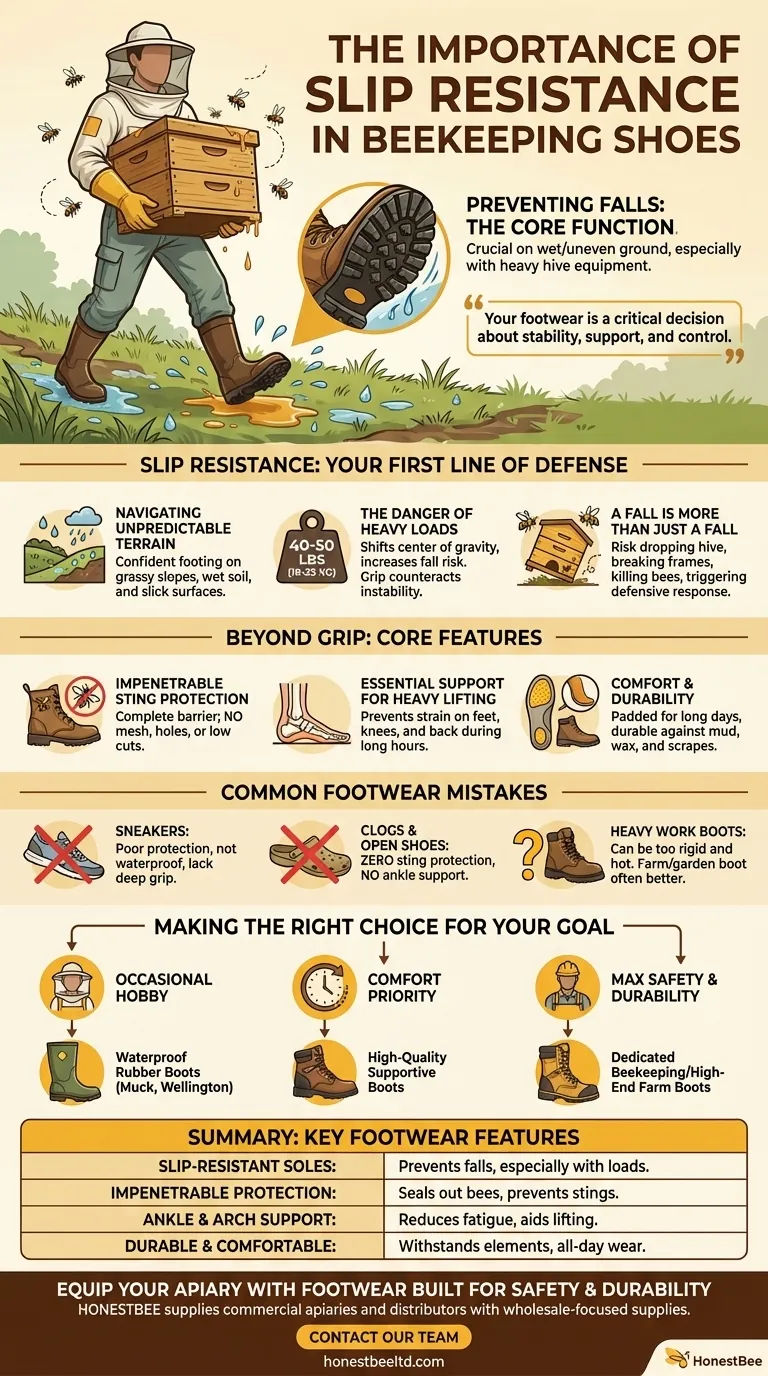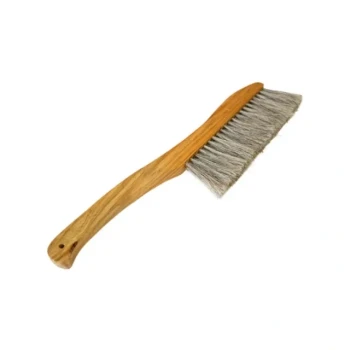At its core, slip resistance is crucial in beekeeping shoes to prevent falls while working on wet or uneven ground, especially when you are carrying heavy hive equipment. A slip in a bee yard isn't just an inconvenience; it can lead to dropping a hive box full of bees, potentially causing a massive defensive reaction, personal injury, and damage to the colony. Your footwear is your primary point of contact with the ground, making its grip a non-negotiable safety feature.
Choosing the right footwear isn't just about avoiding stings on your feet. It's a critical decision about stability, support, and control. The goal is to create a stable foundation that prevents the single most dangerous event in a bee yard: an uncontrolled fall.

Why Slip Resistance is Your First Line of Defense
A beekeeper rarely works on a perfect, flat, dry surface. The apiary is a dynamic environment, and your ability to remain upright is paramount.
Navigating Unpredictable Terrain
Bee yards are often located on grassy fields, uneven dirt, or sloped areas. Morning dew, recent rain, or even spilled sugar syrup can make these surfaces slick and treacherous. A shoe with deep, aggressive treads provides the necessary grip to maintain footing confidently.
The Danger of Carrying Heavy Loads
Lifting a shallow super full of honey can mean lifting 40-50 pounds (18-23 kg). A deep super can be significantly heavier. When you carry this much weight, your center of gravity shifts, making you less stable and more vulnerable to a slip. Slip-resistant soles are essential to counteract this instability.
A Fall is More Than Just a Fall
If you fall while carrying a hive box, you risk breaking frames, killing bees, and potentially injuring the queen. Worse, the sudden shock can trigger a massive defensive response from the colony, putting you and anyone nearby at risk. A secure footing prevents this entire cascade of events.
Beyond Grip: Core Features of Effective Beekeeping Footwear
While slip resistance is critical, a truly effective beekeeping shoe addresses several other needs to ensure you are safe, comfortable, and focused on your bees.
Impenetrable Protection from Stings
Your footwear must provide a complete barrier. Bees can and will crawl into any opening they find. Avoid shoes with ventilation holes (like clogs), mesh panels, or low-cut designs that expose the ankle. Leather or waterproof rubber boots are ideal.
Essential Support for Heavy Lifting
Beekeeping involves long periods of standing, bending, and lifting. Shoes with proper ankle and arch support are crucial for preventing strain on your feet, knees, and back. A supportive boot helps you lift correctly and reduces fatigue over long inspection days.
Comfort and Durability
You will be wearing these shoes for hours at a time, often in warm weather. While protection is key, features like padded insoles and designs that distribute pressure evenly contribute to your overall comfort and endurance. The material must also be durable enough to withstand scrapes, mud, and wax.
Understanding the Trade-offs: Common Footwear Mistakes
Many new beekeepers are tempted to use footwear they already own, but most common shoes present significant problems.
The Problem with Sneakers
While comfortable, typical running shoes or sneakers are a poor choice. Their mesh fabric offers little protection from stings, they are not waterproof, and their soles often lack the deep lugs needed for reliable grip on wet grass.
Why Clogs and Open Shoes are Unacceptable
Any shoe with holes or an open design, such as Crocs or sandals, is an immediate failure for apiary work. They offer zero protection from stings and completely fail to provide the ankle support needed for a safe working environment.
The Limits of Standard Work Boots
Heavy-duty construction boots offer great protection and support, but they can sometimes be too rigid, heavy, and hot for long days in the apiary. Look for a balance; a good farm or garden boot is often a more practical choice than a steel-toed work boot.
Making the Right Choice for Your Goal
Your ideal footwear depends on the scale of your operation and your specific environment.
- If your primary focus is occasional hobby beekeeping: A pair of waterproof rubber boots (like Muck or Wellington boots) with good tread is a perfect, cost-effective solution.
- If your primary focus is comfort during long hours: Prioritize a high-quality leather or rubber boot known for its supportive insole and flexible, yet protective, design.
- If your primary focus is maximum safety and durability for frequent work: Invest in dedicated beekeeping boots or high-end farm boots that combine ankle support, a puncture-resistant upper, and an aggressive, non-slip sole.
Ultimately, your footwear is a foundational piece of safety equipment that enables you to work with confidence and care.
Summary Table:
| Key Feature | Why It Matters for Beekeepers |
|---|---|
| Slip-Resistant Soles | Prevents falls on wet grass, uneven ground, or when carrying heavy hive boxes (40-50 lbs). |
| Impenetrable Protection | Seals out bees to prevent stings; avoid shoes with mesh, holes, or low-cut ankles. |
| Ankle & Arch Support | Reduces fatigue and strain during long hours of standing, bending, and lifting. |
| Durable & Comfortable | Withstands mud, wax, and scrapes while providing comfort for all-day wear. |
Equip your apiary with footwear built for safety and durability. At HONESTBEE, we supply commercial apiaries and beekeeping equipment distributors with wholesale-focused beekeeping supplies designed to prevent accidents and enhance productivity. Don’t compromise on stability—contact our team today to explore our range of slip-resistant beekeeping boots and gear tailored for professionals.
Visual Guide

Related Products
- Thick PVC Material Waterproof Anti-Slip Wear-Resistant Bee Work Shoes Boots for Garden Outdoor Utility
- Professional Galvanized Hive Strap with Secure Locking Buckle for Beekeeping
- Heavy Duty Cowboy Beekeeper Hat with Visibility Veil Outdoor Professional Beekeeping Protective Gear
- Beekeeper Cowboy Hat and Veil for Beekeeping
- HONESTBEE Professional Hive Top Bee Feeder Feeding Solution
People Also Ask
- What is the importance of ensuring no gaps between pants and boots in beekeeping? Prevent Bee Intrusions & Stay Safe
- Why is proper footwear important for beekeepers? Ensure Safety & Stability in the Apiary
- Why is it important to wear boots for beekeeping? Secure Your Apiary Safety from the Ground Up
- What are the key characteristics of good beekeeping shoes? Ensure Maximum Protection and Comfort
- What are some examples of boots used for beekeeping? Essential Protection for Your Apiary Work



















